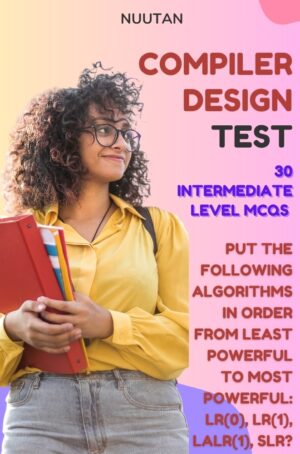Description
Compiler Test: Elevate Your Compiler Design Skills with our Engaging Online Assessment.
Compiler Test Overview:
Answer 60 True/False MCQs in just 30 minutes and aim for a 60% passing rate. Our comprehensive Compiler Test is designed to challenge your understanding of Compiler Design concepts and assess your problem-solving abilities.
Global Reach of Compiler Test:
Tailored for students worldwide, studying Compiler Design in their syllabus. No matter where you are located, our online assessment is readily accessible, enabling students from all corners of the globe to benefit from this valuable learning tool.
For All Students of Compiler Design:
Whether you’re a Compiler Design student anywhere in the world or pursuing B.Tech., M.Tech., BCA, or MCA in India, this test is your gateway to academic excellence. It serves as a comprehensive evaluation of your knowledge, ensuring you are well-prepared for Compiler Design-related challenges.
Crucial Preparation for Competitive Exams:
Invaluable for competitive exams like GATE, NET, SLET, DRDO, and ISRO. Our Compiler Test goes beyond regular academic assessments, offering specialized preparation for prestigious competitive examinations. Prepare with confidence and boost your chances of success in these highly sought-after tests.
Embrace the Challenge of Compiler Test:
Unlock your academic brilliance today with the Compiler Test! Embrace the challenge of 60 thought-provoking True/False MCQs that will test your grasp of Compiler Design principles. Demonstrate your prowess in Compiler Design and set yourself on the path to academic excellence.
Engaging Test Content of Compiler Test:
Experience 60 carefully curated True/False MCQs that challenge your knowledge and problem-solving skills. Our test content is designed to keep you engaged throughout the assessment, fostering active learning and promoting a deeper understanding of Compiler Design concepts.
Time Management in Compiler Test:
Race against the clock in a time-bound setting to enhance your efficiency. As time is of the essence, our test will help you develop essential time management skills, which are vital for tackling time-sensitive academic and professional challenges.
Expert-Crafted Compiler Test:
Prepare with confidence, knowing our test content is crafted by Compiler Design experts. Our team of subject matter specialists ensures the accuracy and relevance of the test questions, providing you with a reliable assessment of your Compiler Design knowledge.
Don’t Miss Out on Compiler Test:
Buy this online Compiler Test and gain a competitive edge in Compiler Design! Don’t miss out on this opportunity to enhance your skills and boost your academic and professional prospects. Prepare to excel in Compiler Design and make a mark in the world of technology and innovation.
Copyright
All rights reserved. Unauthorized reproduction or distribution of this content, in whole or in part, is strictly prohibited. Violators will be held liable under applicable copyright laws. © Nuutan.com, 2023.
Discover an Ocean of Educational Resources! We provide a wide variety of learning materials that you can access through our internal links.
- Nuutan.com is your gateway to a world of information and academic accomplishment. Books in e-book form, multiple-choice question-based online practice tests, practice sets, lecture notes, and essays on a wide range of topics, plus much more!
- Nuutan.com is your one-stop-shop for all kinds of academic e-books, and it will greatly facilitate your educational path.
https://www.nuutan.com/product-category/k12-cuet-iit-jee-neet-gate-university-subjects
- Online multiple-choice tests are available for a variety of subjects on Nuutan.com.
https://www.nuutan.com/product-category/multiple-choice-question
- The Practice Sets on Nuutan.com will improve your performance in any situation.
https://www.nuutan.com/product-category/k12-cuet-iit-jee-neet-gate-cs-btech-mca
- The in-depth lecture notes available on Nuutan.com will significantly improve your academic performance.
https://www.nuutan.com/product-category/k12-cuet-iit-jee-neet-gate-bca-mca-btech-mtech
- Show off your writing chops and gain an edge in educational settings and in the workplace with Profound Essays from Nuutan.com.
https://www.nuutan.com/product-category/k12-competitive-exams-essays
- Nuutan.com is a treasure trove of knowledge thanks to its free academic articles covering a wide variety of subjects. Start your academic engine!
https://www.nuutan.com/nuutans-diary
- Discover our roots and learn how Nuutan.com came to be. Read up about us on the “About Us” page of our website!
https://www.nuutan.com/about-us
- Embrace a Future of Knowledge and Empowerment! is the vision of the future that Nuutan.com has unveiled.
- Become an author by publishing your work on the Nuutan.com platform.
https://www.nuutan.com/create-a-publication-with-us
The External Link Related to This Academic Product:
- GOOGLE BOOKS: Here are a few Google links to help you learn about Compiler Design, including Automata Theory, which is also very helpful for getting a good grasp of Compiler Design.
(1) Mastering Compiler Design: Your Ultimate MCQ Guide to Exam Success
https://books.google.co.in/books/about/Compiler_Design_MCQ_Book.html?id=oZuLEAAAQBAJ&redir_esc=y
(2) Compiler Design MCQs: An Ultimate Practice Book
(3) Automata Theory – A Step-by-Step Approach (Lab/Practice Work with Solution)
- YOUTUBE VIDEO:
https://www.youtube.com/watch?v=5yFdTSbqsWE
- SCRIBD:
https://www.scribd.com/document/489307274/compiler-design-multiple-choice-questions-answers-1-pdf#
- ACADEMIA:
https://www.academia.edu/36463069/Compiler_mcq
- SLIDESHARE:
https://www.slideshare.net/SatyamJaiswal54/compiler-design-quiz
- COURSE HERO:
https://www.coursehero.com/file/129056939/Compiler-MCQ-CS-702pdf/
- BYJU’S EXAM PREP:
https://byjus.com/gate/compiler-design-mcqs/
- DOCSITY:
https://www.docsity.com/en/compiler-design-mcq/7356849/
- OPENGENUS:
https://iq.opengenus.org/compiler-design-mcq/
- STUDOCU:
- GRADUATE APTITUDE TEST IN ENGINEERING (GATE) 2024:
- UGC NET ONLINE (SYLLABUS AVAILABLE ONLINE):
- DRDO (CAREER WEBSITE) – RECRUITMENT AND ASSESSMENT CENTRE (RAC):
https://rac.gov.in/index.php?lang=en&id=0
- ISRO (CAREER WEBSITE):
https://www.isro.gov.in/Careers.html
- STATE LEVEL ELIGIBILITY TEST (SLET) – ASSAM NE REGION:
- STANFORD ONLINE:
https://online.stanford.edu/courses/soe-ycscs1-compilers
- IEEE XPLORE (COMPILER DESIGN RESEARCH PAPERS):
https://ieeexplore.ieee.org/document/7814827
As a result of your constant backing and encouragement, Nuutan.com is extremely appreciative and thankful.









